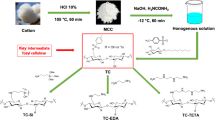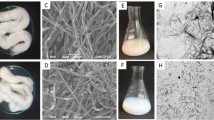Abstract
Lysozyme was attached through an amide linkage between some of the protein’s aspartate and glutamate residues to amino-glycine-cellulose, which was prepared by esterification of glycine to preparations of cotton nanocrystals. The nanocrystalline preparations were produced through acid hydrolysis and mechanical breakage of the cotton fibers from a scoured and bleached cotton fabric and a scoured and bleached, mercerized fabric, which was shown to produce cellulose I (NCI) and cellulose II (NCII) crystals respectively. A carbodiimide-activation coupling reaction was used to create the lysozyme-amino-glycine-cellulose conjugates using both NCI and NCII in a polar solvent and gave yields of covalently linked lysozyme at 604 mg/gram of cotton nanocrystal. The incorporation of lysozyme conjugated to the NCI and NCII preparations gave very high activity (1,500 U/mg cotton) when assessed using a fluorescence tag assay to measure antimicrobial activity against Micrococcus lysodeikticus. Scanning electron micrographs demonstrated an aggregation of nanoparticles corresponding to lysozyme bound on the surface of larger cotton nanocrystalline sheets. The approach of producing high enzyme activity on cotton nanocrystals is discussed in the context of selectively presenting robust hydrolase activity on nanocrystalline surfaces.







Similar content being viewed by others
References
Akgol S, Ozturk N, Denizli A (2010) New generation of polymeric nanospheres for lysozyme adsorption. J Appl Polym Sci 115:1608–1615
Bhattacharyya MS, Hiwale P, Piras M, Medda L, Steri D, Piludu M, Salis A, Monduzzi M (2010) Lysozyme and release form ordered mesoporous materials. J Phys Chem C 114:19928–19934
Callewaert L, Michiels CW (2010) Lysozymes in the animal kingdom. J Biosci 35:127–160
Caro A, Humblot V, Methivier C, Minier M, Barbes L, Joachim L, Salmain M, Pradier C-M (2010) Bioengineering of stainless steel surface by covalent immobilization of enzymes. Physical characterization and interfacial enzymatic activity. J Colloid Interface Sci 349:13–18
Cisani G, Varaldo PE, Pompei R, Valiesena S, Satra G (1989) Cell fusion induced by herpes simplex is inhibited by hen egg-white lysozyme. Microbios 59:73–83
Clibbens DA (1923) The mercerization of cotton: a review of the literature. J Text Inst (Trans) 14:217–249
De Rham O (1982) Nitrogen content of proteins and protein/nitrogen conversion factor. Lebensmittel-Wissenschaft-und-Technolo 15:226–231
Diamond G, Legardo D, Ryan LK (2000) The innate immune response of the respiratory epithelium. Immunol Rev 173:27–38
Eby DM, Schaeublin NM, Farrington KE, Hussein SM, Johnson GR (2009) Lysozyme catalyzes the formation of antimicrobial silver nanoparticles. ACS Nano 3:984–994
Edwards JV, Sethumadhavan K, Ullah AHJ (2000) Conjugation and modeled structure/function analysis of lysozyme on glycine esterified cotton cellulose fibers. Bioconj Chem 11:469–473
Edwards JV, Prevost NT, Condon B, Sethumadhavan K, Ullah J (2011a) Immobilization of lysozyme on cotton fabrics: synthesis, characterization, and activity. AATCC Rev 11:73–79
Edwards JV, Prevost NT, Condon B, French A (2011b) Covalent attachment of lysozyme to cotton/cellulose materials: protein verses solid support activation. Cellulose 18:1239–1249
Fleming A (1922) On a remarkable bacteriolytic element found in tissues and secretions. Proc R Soc Lond (Biol) 93:306–317
Ganz T, Gabayan V, Liao HI, Liu L, Oren A, Graf T, Cole AM (2003) Increased inflammation in lysozyme M-deficient mice in response to micrococcus luteus and its peptidoglycan. Blood 101:2388–2392
Gao P, Cai Y (2008) The boundary molecules in a lysozyme pattern exhibit preferential antibody binding. Langmuir 24:10334–10339
Hancock RE, Scott MG (2000) The role of antimicrobial peptides in animal defenses. Proc Natl Acad Sci USA 97:8856–8861
Hebert JJ, Boylston EK, Wadsworth JI (1979) Cross-sectional parameters of cotton fibers. Text Res J 49:540–542
Hill SE, Robinson J, Matthews G, Muschol M (2009) Amyloid protofibrils of lysozyme nucleat and grow via oligomer fusion. Biophys J 96:3781–3790
Hu Y-J, Fan X-R, Wang Q, Wang P, Cui L (2008) Immobilization of lysozyme on wool fabric. Wool Text J 10:15–18
Imoto T, Johson LN, North ACT, Philips DC, Rupley JA (1972) Vertebrate lysozymes. In: Boyer PD (ed) The enzymes, 3rd edn. Academic Press, New York, pp 666–868
Kiersnowski A, Serwadczak M, Kulaga W, Futoma-Koloch B, Bugla-Ploskonska G, Kwiatkowski R, Doroszkiewicz W, Piglowski J (2009) Delamination of montmorillonite in serum–a new approach to obtaining clay-base biofunctional hybrid materials. Appl Clay Sci 44:225–229
Krimm S (2000) Infrared analysis of peptide and proteins, principles and applications, ACS symposium series 750. Oxford University Press, New York, pp 38–53
Kubiak-Ossowka K, Mulheran PA (2010) What governs adsorption and immobilization at a charged solid surface? Langmuir 26:7690–7694
Lampis G, Deidda D, Pinza M, Pompei R (2001) Enhancement of anti-herpetic activity of glycyrrhizic acid by physiological proteins. Antivir Chem Chemother 12:125–131
Langan P, Nishiyama Y, Chanzy H (2001) X-ray structure of mercerized cellulose II at 1 Å resolution. Biomacromolecules 2:410–416
Lee-Huang S, Maiorov V, Huang PL, Ng A, Hee CL, Chang Y-T, Kallenbach N, Huang PL, Chen H-C (2005) Structural and functional modeling of human lysozyme reveals a unique nonapeptide, HL9, with anti-HIV activity. Biochemistry 44:4648–4655
Lei J, Fan J, Yu C, Zhang L, Jiang S, Tu B, Zhao D (2004) Immobilization of enzymes in mesoporous materials controlling the entrance to nanospace. Microporous Mesoporous Mater 73:121–128
Mahmoud KA, Male KB, Hrapovic S, Luong JHT (2009) Cellulose nanocrystal/gold nanoparticle composite as a matrix for enzyme immobilization. Appl Mater Interfaces 1:1383–1386
Nevell TP, Zeronian SH (eds) (1985) Cellulose chemistry and its applications. Ellis Horwood Ltd, Chichester
Nishiyama Y, Chanzy H, Langan PJ (2002) Crystal structure and hydrogen-bonding system in cellulose Iβ from synchrotron X-ray and neutron fiber diffraction. J Am Chem Soc 124:9074–9082
Prisbrey L, Schneider G, Minot E (2010) Modeling the electrostatic signature of single enzyme activity. J Phys Chem B 114:3330–3333
Ramanathan M, Luckarift HR, Sarsenova A, Wild JR, Ramanculov EK, Olsen EV, Simonian AL (2009) Lysozyme-mediated formation of protein-silica nano-composites for biosensing applications. Colloids Surf B Biointerfaces 73:58–64
Rollins ML (1954) Some aspects of microscopy in cellulose research. Anal Chem 26:718–724
Salton MRJ (1957) The properties of lysozyme and its action on microorganisms. Bact Rev 21:82–100
Samaranayake YH, Smaranayake LP, Pow EHN, Beena VT, Yeung KWS (2001) Antifungal effects of lysozyme and lactoferrin against genetically similar, sequential candida albicans isolates from a human immunodeficiency virus-infected southern Chinese cochort. J Clin Microbiol 39:3296–3302
Sevilla M, Valle-Vigon P, Tartaj P, Fuertes AB (2009) Magnetically separable bimodal mesoporous carons with a large capacity for the immobilization of biomolecules. Carbon 47:2519–2527
Siro I, Plackett D (2010) Microfibrillated cellulose and new nanocomposite materials: a review. Cellulose 17:459–494
Strynadka NC, James MN (1996) Lysozyme: a model enzyme in protein crystallography. EXS 75:185–222
Tripp VW, Moore AT, Rollins ML (1954) A microscopical study of the effects of some typical chemical environments on the primary wall of the cotton fiber. Text Res J 24:956–970
Van den Berg O, Capadona JR, Weder C (2007) Preparation of homogeneous dispersions of tunicate cellulose whiskers in organic solvents. Biomacromolecules 8:1353–1357
Vauthier C, Bouchemal K (2009) Methods for the preparation and manufacture of polymeric nanoparticles. Pharm Res 26:1025–1058
Wang Q, Fan X, Hu Y, Yuan J, Cui L, Wang P (2009) Antibacterial functionalization of wool fabric via immobilizing lysozyme. Bioprocess Biosyst Eng 32:633–639
Warwicker JO, Jefferies R, Colbran RL, Robinson RN (1966) A review of the literature on the effect of caustic soda and other swelling agents on the fine structure of cotton no. 93. Shirley Institute, Manchester
Wertz J-L, Bédué O, Mercier JP (2011) Cellulose science and technology. EPFL Press, Lausanne
Yang R, Tan H, Wei F, Wang S (2008) Peroxidase conjugate of cellulose nanocrystals for the removal of chlorinated phenolic compounds in aqueous solution. Biotechnology 7:233–241
Yue YY (2011) A comparative study of cellulose I and II fibers and nanocrystals. Thesis, Louisiana State University
Acknowledgments
The authors thank Elisha Josepha and Professor John Wiley for the X-ray analyses.
Author information
Authors and Affiliations
Corresponding author
Rights and permissions
About this article
Cite this article
Edwards, J.V., Prevost, N.T., Condon, B. et al. Immobilization of lysozyme-cellulose amide-linked conjugates on cellulose I and II cotton nanocrystalline preparations. Cellulose 19, 495–506 (2012). https://doi.org/10.1007/s10570-011-9637-5
Received:
Accepted:
Published:
Issue Date:
DOI: https://doi.org/10.1007/s10570-011-9637-5




